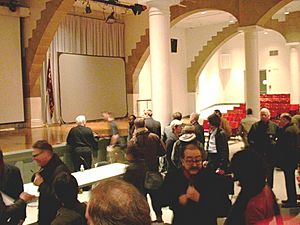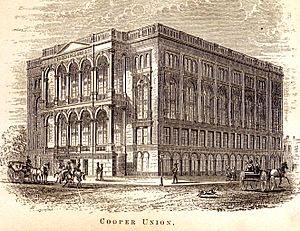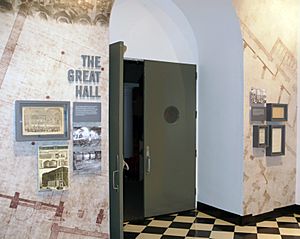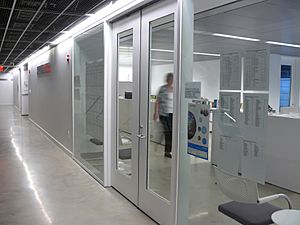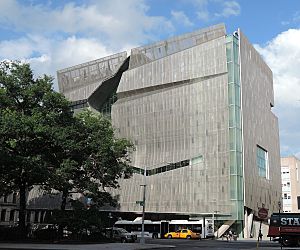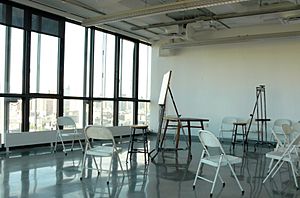Cooper Union facts for kids
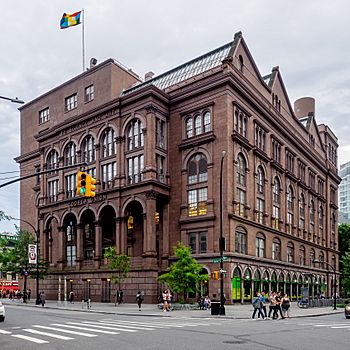
The Cooper Union's Foundation Building at Cooper Square and Astor Place in 2019
|
|
| Type | Private college |
|---|---|
| Established | 1859 |
| Accreditation | MSCHE |
| Endowment | $920 million (2021) |
| President | Laura Sparks |
|
Academic staff
|
57 (full time) (2017/2018) |
| Students | 800–900 |
| Location |
Manhattan, New York City
,
New York
,
United States
|
| Campus | Urban |
| Colors | Maroon and Gold |
 |
|
|
The Cooper Union
|
|
| Location | Cooper Square Manhattan, New York City |
| Built | 1858–59 |
| Architect | F.A. Peterson |
| NRHP reference No. | 66000540 |
| Significant dates | |
| Added to NRHP | October 15, 1966 |
| Designated NHL | July 4, 1961 |
Cooper Union for the Advancement of Science and Art, commonly known as Cooper Union, is a private college on Cooper Square in Lower Manhattan, New York City. Peter Cooper founded the institution in 1859 after learning about the government-supported École Polytechnique in France. The school was built on a radical new model of American higher education based on Cooper's belief that an education "equal to the best technology schools established" should be accessible to those who qualify, independent of their race, religion, sex, wealth or social status, and should be "open and free to all".
The college is divided into three schools: the Irwin S. Chanin School of Architecture, the School of Art, and the Albert Nerken School of Engineering. It offers undergraduate and master's degree programs exclusively in the fields of architecture, fine arts (undergraduate only), and engineering.
Cooper Union was one of very few American institutions of higher learning to offer a full-tuition scholarship to every admitted student, a practice it discontinued in 2014, now offering a half-tuition scholarship to each admitted student. Admission to Cooper Union is competitive, with an acceptance rate of 12% across the three schools.
History
Founding and early history
The Cooper Union was founded in 1859 by American industrialist Peter Cooper, one of the richest businessmen in the United States. Cooper was a workingman's son who had less than a year of formal schooling. Cooper designed and built America's first steam railroad engine and made a fortune with a glue factory and iron foundry. He was a principal investor and first president of the New York, Newfoundland and London Telegraph Company, which laid the first transatlantic telegraph cable, and once ran for President under the Greenback Party, becoming the oldest person ever nominated for the office by a political party.
Cooper's dream was to give talented young people the one privilege he lacked: a good education from an institution which was "open and free to all". To achieve these goals, Cooper designated the bulk of his wealth to The Cooper Union. According to The New York Times in 1863, "It was rare that those of limited means, however eager they might be to acquire a knowledge of some of the higher branches of education, could obtain tuition in studies not named in the regular course taught in our public schools." Discrimination based on ethnicity, religion, or sex was expressly prohibited.
Development after founding
Originally intended to be named simply "the Union", the Cooper Union began with adult education in night classes on the subjects of applied sciences and architectural drawing, as well as day classes primarily intended for women on the subjects of photography, telegraphy, typewriting and shorthand in what was called the college's Female School of Design. The early institution also had a free reading room open day and night, the first in New York City (predating the New York Public Library system), and a new four-year nighttime engineering college for men and a few women. In 1883, a five-year curriculum in chemistry was added as an alternative to the applied science (engineering) program. A daytime engineering college was added in 1902, thanks to funds contributed by Andrew Carnegie. Initial board members included Daniel F. Tiemann, John E. Parsons, Horace Greeley and William Cullen Bryant, and those who availed themselves of the institute's courses in its early days included Augustus Saint-Gaudens, Thomas Alva Edison and William Francis Deegan.
The Cooper Union's free classes have evolved into three schools: the School of Art, the Irwin S. Chanin School of Architecture, and the Albert Nerken School of Engineering. Since 1859, the Cooper Union has educated thousands of artists, architects, and engineers, many of them leaders in their fields.
After 1864 there were a few attempts to merge Cooper Union and Columbia University, but these were never realized.
The Cooper Hewitt, Smithsonian Design Museum, was founded in 1897 as part of Cooper Union by Sarah, Eleanor, and Amy Hewitt, granddaughters of Peter Cooper.
Structure-building era
The Foundation Building
Cooper Union's Foundation Building is an Italianate brownstone building designed by architect Fred A. Petersen, one of the founders of the American Institute of Architects. It was the first structure in New York City to feature rolled-iron I-beams for structural support; Peter Cooper himself invented and produced these beams. Petersen patented a fire-resistant hollow brick tile he used in the building's construction. The building was the first in the world to be built with an elevator shaft, because Cooper, in 1853, was confident an elevator would soon be invented. However, he expected them to be cylindrical, so he designed the shaft in the shape of a circle. The building was declared a National Historic Landmark in 1961, and a New York City Landmark in 1965, and added to the Historic American Engineering Record in 1971.
The Foundation Building's Great Hall
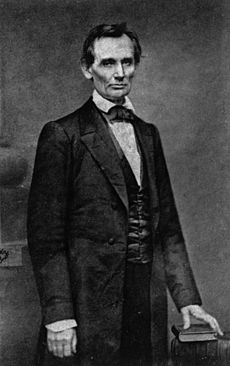
On February 27, 1860, the school's Great Hall, located in the basement level of the Foundation Building, became the site of a historic address by Abraham Lincoln. "Lincoln made his address on a snowy night before about 1,500 persons."
Widely reported in the press and reprinted throughout the North in pamphlet form, the speech galvanized support for Lincoln and contributed to his gaining the Party's nomination for the presidency. It is now referred to as the Cooper Union Address.
Since then, the Great Hall has served as a platform for historic addresses by American Presidents Grant, Cleveland, Taft, Theodore Roosevelt, Woodrow Wilson, and Bill Clinton. Clinton spoke on May 12, 1993, about reducing the federal deficit and again on May 23, 2006, as the Keynote Speaker at The Cooper Union's 147th Commencement, along with Anna Deavere Smith. He appeared a third time on April 23, 2007, along with Senator Edward Kennedy, Henry Kissinger, Norman Mailer, and others, at the memorial service for historian Arthur M. Schlesinger Jr. Most recently, Barack Obama delivered an economic policy speech at Cooper Union's Great Hall on April 22, 2010. On September 22, 2014, President of the Palestinian National Authority Mahmoud Abbas delivered his first formal speech in English.
Other speakers in the Great Hall have included Frederick Douglass, Susan B. Anthony, Elizabeth Cady Stanton, and Mark Twain.
The Great Hall continues to serve as an important metropolitan art space and has hosted lectures and performances by such key figures as Joseph Campbell, Steve Reich, Salman Rushdie, Ralph Nader, Hamza Yusuf, Richard Stallman, Rudolph Giuliani, Pema Chodron, Michael Bloomberg, Evo Morales, and Venezuelan president Hugo Chávez. When not occupied by external or hosted events, the Great Hall is made accessible to students and faculty for large lectures and recreational activities, including the school's annual Culture Show. In 1994, the Cooper Union Forum of Public Programs was honored with a Village Award from the Greenwich Village Society for Historic Preservation.
In late 2008, the Great Hall was closed to students and outside events for the first major renovation of the hall since 1978.
Modern changes
The Cooper Union has schools in architecture, fine art, and engineering. At present, these three fields represent Cooper Union's degree programs. The Faculty of Humanities and Social Studies provides classes and faculty to all three programs.
In 2002, the school decided to generate revenue by razing its engineering building and having it replaced with a commercial building, and replacing its Hewitt Building with a new building called 41 Cooper Square.
41 Cooper Square
A new classroom, laboratory, and studio facility designed by Thom Mayne replaced the aging Hewitt Academic Building at 41 Cooper Square. In contrast to the Foundation Building, 41 Cooper Square is of modern, environmentally "green" design, housing nine above-ground floors and two basements. The structure features unconventional architectural features, including a full-height Grand Atrium, prevalent interior windows, a four-story linear central staircase, and upper-level skyways, which reflect the design intention of inspiring, socially interactive space for students and faculty. In addition, the building's design allows for up to 75% natural lighting, further reducing energy costs. In 2010, 41 Cooper Square became the first academic and laboratory structure in New York City to meet Platinum-level LEED standards for energy efficiency. The building was funded in part by alumni donations, materialized in nameplates and other textual recognition throughout the building.
Primarily designed to house the Cooper Union's School of Engineering and School of Art, the new building's first eight above-ground floors are populated by classrooms, small engineering laboratories, study lounges, art studio space, and faculty offices. The ninth, top floor is dedicated completely to School of Art studio and classroom space in addition to the art studio spaces located throughout the building. The lowest basement level consists almost completely of the school's large machine shops and design laboratories, as well as much of the HVAC and supply infrastructure. The building's first basement level houses primarily the Frederick P. Rose Auditorium, a 198-capacity lecture hall and event space designed as a smaller, more modern alternative to the Great Hall.
Financial support
A substantial portion of the annual budget, which supports the full-tuition scholarships in addition to the school's costs, is generated through revenues from real estate. Its endowment is over $600 million. The land under the Chrysler Building is owned by the endowment, and as of 2009, Cooper Union received $7 million per year from this parcel. Further, under a very unusual arrangement, New York City real-estate taxes assessed against the Chrysler lease, held by Aby Rosen, are paid to Cooper Union, not the city. This arrangement would be voided if Cooper Union sold the real estate. In 2006, Tishman Speyer signed a deal with the school to pay rent that has escalated to $32.5 million in 2018.
Academics
|
|
The Albert Nerken School of Engineering
The Cooper Union's School of Engineering is named in honor of Albert Nerken, a chemical engineering alumnus of the school. Its enrollment includes about 550 students, and is the largest of the three schools by a significant margin. The school offers ABET-accredited Bachelor of Engineering (BE) degree programs in core engineering fields and an interdisciplinary Bachelor of Science in Engineering (BSE) degree. Opportunities are also available for engineering students to pursue minors in bioengineering, chemistry, computer science, humanities and social sciences, and mathematics.
Specialized facilities for teaching and research include the Maurice Kanbar Center for Biomedical Engineering established in 2002 and the interdisciplinary Maker Space Lab, established in 2020 for the use of engineering, art, and architecture students.
Master's in Engineering
The School of Engineering offers master's degrees in chemical, civil, electrical, or mechanical engineering. Cooper Union undergraduate engineering students may earn a bachelor's degree and a master's degree in as little as five years.
The School of Art
Consisting of roughly 200 students and 70 faculty members, the Cooper Union School of Art offers a Bachelor of Fine Arts (BFA) degree and a Certificate of Fine Arts. As a member school of AICAD, School of Art students may participate in exchange programs with the other colleges in the association, including California Institute of the Arts and Otis College of Art and Design.
The Cooper Union Art program is often referred to as "generalist" or "versatile" when compared to other Fine Arts colleges; incoming students do not choose an academic major within the Fine Arts field, but instead are permitted and encouraged to select courses from any of the School of Art's departments. The curriculum place heavy emphasis on each student's creative and imaginative abilities, rather than technical precision in a specific medium.
Galleries
Located in both public spaces and specialized rooms, Cooper Union's galleries provide space for installations and showcases by students, faculty, and guest artists. Popular gallery locations include the Great Hall lobby in the Foundation Building and newly opened 41 Cooper Gallery in 41 Cooper Square, which provides a two-story high space for large, three-dimensional exhibitions and works visible from both the building lobby and 7th street through large plate-glass windows.
In addition, numerous smaller exhibition spaces exist throughout both buildings on campus. Larger spaces on the upper floors of the Foundation Building are used primarily for interdisciplinary exhibitions with the School of Architecture. For presentations of video and digital media, the Great Hall and 41 Cooper Square's Rose Auditorium are used.
Irwin S. Chanin School of Architecture
The Irwin S. Chanin School of Architecture at the Cooper Union offers a five-year NAAB accredited program established by John Hejduk. The philosophical foundation of the school was directly committed to the "Social Contract" and dedicated to education as "one of the last places that protects freedom, and teaching as a sociopolitical act, among other things." among those other things were principles of free debate and theoretical discourse which drew source from deep wellsprings of lost histories such as the Bauhaus school of Architecture founded by Ludwig Mies van der Rohe.
The faculty includes architects, design and construction managers such as Peter Eisenman, Samuel Anderson, Nader Tehrani, and Diana Agrest. Former faculty members include the architects Michael Webb, Peter Eisenman, Raimund Abraham, Lebbeus Woods, Diane Lewis and John Hejduk.
Master of Architecture II
The post-professional degree program in architecture was launched in 2009. Concentrations in one or a combination of three areas are offered: theory, history and criticism of architecture, urban studies and technologies.
Athletics
Cooper Union has developed an athletic program which fields teams in basketball, volleyball, and soccer.
Notable alumni
Awards received by Cooper Union alumni include one Nobel Prize in Physics, a Pritzker Prize, fifteen Rome Prizes, 26 Guggenheim Fellowships, three MacArthur Fellowships, nine Chrysler Design Awards, three Emmy Awards, one Tony, one Grammy, one Queen Elizabeth Prize for Engineering, and three Thomas Jefferson Awards for Public Architecture, which is sponsored by the American Institute of Architects. The school also boasts 39 Fulbright Scholars since 2001, and thirteen National Science Foundation Graduate Research Fellowships since 2004.
Notable faculty
Notable faculty of the Cooper Union include:
- Raimund Abraham, architect
- Diana Agrest, architect
- William Arnold Anthony, physicist
- George Herman Babcock, inventor
- Eleanor K. Baum, electrical engineer
- Mary Blade, mechanical engineer
- Teresa Abi-Nader Dahlberg, academic administrator and electrical engineer
- John Christopher Draper, chemist and surgeon
- Thomas Eakins, painter
- Peter Eisenman, architect
- William Germano, editor
- Charles Gwathmey, architect
- Hans Haacke, artist
- John Hejduk, architect
- Basil King, painter and writer
- Jonas Mekas, filmmaker
- Margaret Morton, photographer and artist
- Aldo Rossi, architect
- Ricardo Scofidio, architect
- Ysrael Seinuk, structural engineer
- David Shapiro, poet
- Nina Tandon, biomedical engineer
- William Wiswesser, chemist; inventor of Wiswesser line notation
- Lebbeus Woods, architect
- John Celivergos Zachos, physician, inventor and literary scholar
See also
 In Spanish: Cooper Union para niños
In Spanish: Cooper Union para niños
- Presidents of Cooper Union
- Association of Independent Technological Universities


